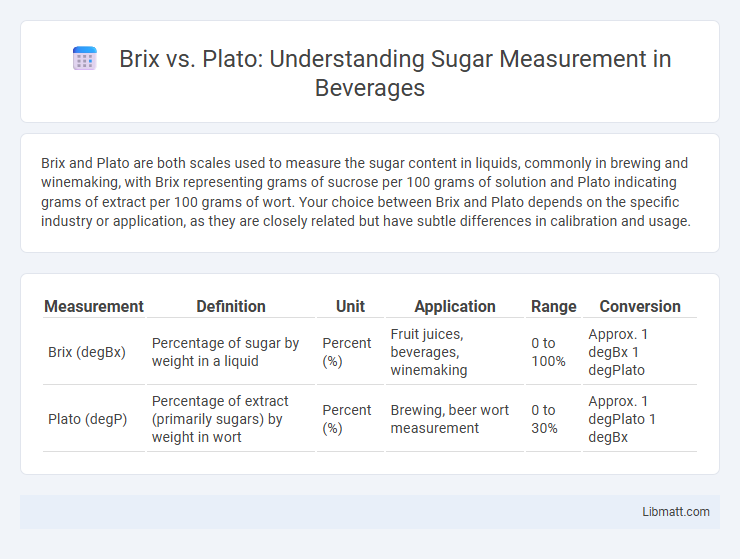Brix and Plato are both scales used to measure the sugar content in liquids, commonly in brewing and winemaking, with Brix representing grams of sucrose per 100 grams of solution and Plato indicating grams of extract per 100 grams of wort. Your choice between Brix and Plato depends on the specific industry or application, as they are closely related but have subtle differences in calibration and usage.
Table of Comparison
| Measurement | Definition | Unit | Application | Range | Conversion |
|---|---|---|---|---|---|
| Brix (degBx) | Percentage of sugar by weight in a liquid | Percent (%) | Fruit juices, beverages, winemaking | 0 to 100% | Approx. 1 degBx 1 degPlato |
| Plato (degP) | Percentage of extract (primarily sugars) by weight in wort | Percent (%) | Brewing, beer wort measurement | 0 to 30% | Approx. 1 degPlato 1 degBx |
Understanding Sugar Measurement in Brewing
Brix and Plato are scales used to measure the sugar content in brewing wort, both expressing the concentration of dissolved solids as a percentage by weight. Plato is specifically designed for brewing and correlates more accurately with wort density and fermentable extract, making it the preferred measurement in professional brewing settings. While Brix is widely used in the food industry and for general sugar solutions, brewers favor Plato for precise control over fermentation and final beer flavor profiles.
What is Brix?
Brix is a scale used to measure the sugar content in an aqueous solution, representing the percentage of sucrose by weight. It is commonly applied in industries such as winemaking, brewing, and fruit juice production to assess sweetness and fermentation potential. Your accurate Brix measurement helps ensure product consistency and quality control.
What is Plato?
Plato is a scale measuring the concentration of dissolved solids, primarily sugars, in wort or must during brewing and winemaking, expressed as degrees Plato (degP). One degree Plato corresponds to 1 gram of sucrose per 100 grams of solution, offering a precise indication of potential alcohol content. Plato is essential for brewers and vintners to monitor fermentation progress and ensure product consistency compared to other scales like Brix.
Historical Background of Brix and Plato Scales
The Brix scale, developed in the late 19th century by Adolf Brix, measures the sugar content in liquids by indicating the percentage of sucrose by weight. The Plato scale, introduced by Fritz Plato in the early 20th century, serves a similar purpose but typically evaluates the density of wort in brewing to estimate fermentable extract. Both scales have historical significance in food and beverage industries, with Your choice depending on regional preferences and industry standards.
Key Differences Between Brix and Plato
Brix and Plato scales both measure sugar concentration in liquids but differ in their scientific basis and precision, with Brix representing grams of sucrose per 100 grams of solution and Plato indicating the percentage of extract or dissolved solids by weight. Plato is commonly used in brewing and provides a more accurate representation of wort concentration, while Brix is widely applied in winemaking and fruit juice industries. Your choice between Brix and Plato depends on the specific application and required measurement accuracy for sugar content analysis.
Conversion Methods: Brix to Plato and Vice Versa
Brix and Plato scales both measure sugar content in liquids, with Brix representing grams of sucrose per 100 grams of solution and Plato indicating grams of extract per 100 grams of wort. Converting Brix to Plato involves multiplying the Brix value by approximately 0.968, while converting Plato to Brix requires dividing the Plato value by 0.968 to ensure precise sugar concentration readings. Accurate conversion methods help you maintain consistency in brewing, winemaking, and quality control processes.
Accuracy and Practicality in Brewing and Winemaking
Brix and Plato scales both measure sugar concentration in wort and grape must, but Plato is generally more accurate for brewing due to its calibration against sucrose solutions, reflecting true extract content and specific gravity. Brix, based on refractive index, offers quick and practical readings ideal for winemaking, where rapid assessment of sugar levels is essential during fermentation. Winemakers often prefer Brix for its ease of use, while brewers rely on Plato for precise control over fermentation performance and final alcohol content.
Industry Preferences: Brix vs Plato Usage
Brix and Plato scales both measure sugar content in liquid solutions, but industry preferences vary based on application and region. The brewing industry predominantly uses the Plato scale for its accuracy in representing fermentable extract concentration, while the wine industry commonly adopts the Brix scale due to its ease of use and widespread recognition. Distilleries and juice manufacturers may choose between Brix or Plato depending on equipment calibration and regional standards, with Brix being more prevalent in American and wine sectors, and Plato favored in European brewing contexts.
Choosing the Right Scale for Your Application
Brix and Plato scales both measure sugar concentration in liquids, with Brix commonly used in winemaking and soft drinks, while Plato is preferred in brewing for its accurate representation of fermentable sugars. Selecting the appropriate scale depends on the industry and precision requirements; Brix offers a straightforward percentage of sugar by weight, whereas Plato provides a close approximation to extract potential and original gravity in malted beverages. Understanding the differences ensures optimal process control and product consistency in applications like fermentation and quality testing.
Frequently Asked Questions about Brix and Plato
Brix and Plato scales both measure sugar content in liquids, with Brix representing the percentage of sucrose by weight and Plato reflecting the concentration of extract in wort brewing. Frequently asked questions often cover their interchangeability, accuracy in brewing and winemaking, and how to convert between the two scales since 1o Plato approximately equals 1o Brix. Understanding these differences ensures your measurements during fermentation or quality control are precise and reliable.
Brix vs Plato (sugar measurement) Infographic

 libmatt.com
libmatt.com